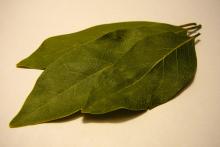One is a tasty spice - the other is edible, but dubious
Bay leaves are one of those magical herbal ingredients that not only flavor a sauce or soup, they seem to bring the whole thing together. It's a pity that they are A) so expensive, and B) something I don't use often enough. It's one of those spices that I can almost guarantee you will always be stale in my cupboard.
I was intrigued when my neighbor offered to let me pull leaves off of her "bay tree" and use them whenever I liked. The prospect of fresh bay was exciting, I had never tried it fresh, and I know that most herbs are so much more delicious fresh! What was growing in her yard sure looked like bay leaves, but when I crushed the leaves between my fingers, they smelled like camphor and eucalyptus.
Back at home I did a bit of research and found out what was going on. My neighbor, like many people on the west coast, has a California Bay Laurel tree (Umbellularia californica). This is a bushy shrub or small tree which has a lot of colloquial names, among them "Headache tree."
Bay leaves as you find at the store are from a related shrub, the Bay Laurel (Laurus nobilis). Bay Laurel likes a hot Mediterranean climate, while California Bay Laurel prefers cooler environments like those found on the Oregon and Washington maritime climate.
Both Bay Laurel and California Bay Laurel leaves are rich in a lot of pungent essential and volatile oils. California Bay Laurel leaves are edible, it's true, but they have a much higher percentage of menthol and eucalyptol. (Which explains why, the one time I tried using it in roast chicken, my dinner ended up tasting like a cough drop.) California Bay Laurel also contains a considerable amount of Umbellulone, which is a ketone that causes headaches.
(Incidentally, Texas Mountain Laurel is thought to have hallucinogenic properties, but this is largely due to a case of mistaken identity. Texas Mountain Laurel is a legume which is not related to either Bay Laurel, and it is very toxic. Neither California Bay Laurel nor regular Bay Laurel contain hallucinogenic substances. Although I have been told that if you dry and smoke California Bay Laurel leaves, you develop a splitting headache, which I have no doubt is true.)
California Bay Laurel makes a very nice addition to the yard, and the scent of its leaves is an interesting perk. But I wouldn't recommend cooking with it, unless you fancy food that tastes like a cough drop and gives you a headache.
